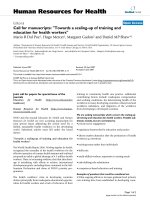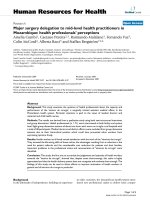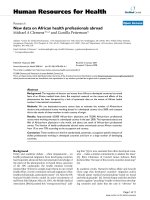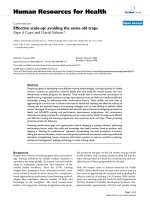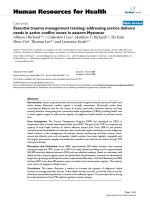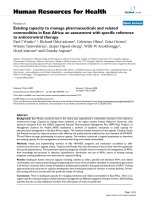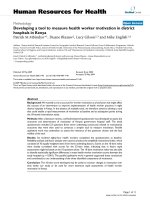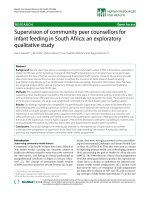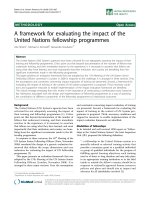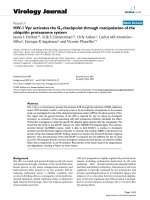Báo cáo sinh học: " Special issue on "Towards the connected body: advances in body communications"" pdf
Bạn đang xem bản rút gọn của tài liệu. Xem và tải ngay bản đầy đủ của tài liệu tại đây (87.32 KB, 6 trang )
This Provisional PDF corresponds to the article as it appeared upon acceptance. Fully formatted
PDF and full text (HTML) versions will be made available soon.
Special issue on "Towards the connected body: advances in body
communications"
EURASIP Journal on Wireless Communications and Networking 2011,
2011:203 doi:10.1186/1687-1499-2011-203
Philippe De Doncker ()
Jun-Ichi Takada ()
Arie Reichman ()
Dries Neirynck ()
ISSN 1687-1499
Article type Editorial
Submission date 25 August 2011
Acceptance date 16 December 2011
Publication date 16 December 2011
Article URL />This peer-reviewed article was published immediately upon acceptance. It can be downloaded,
printed and distributed freely for any purposes (see copyright notice below).
For information about publishing your research in EURASIP WCN go to
/>For information about other SpringerOpen publications go to
EURASIP Journal on Wireless
Communications and
Networking
© 2011 De Doncker et al. ; licensee Springer.
This is an open access article distributed under the terms of the Creative Commons Attribution License ( />which permits unrestricted use, distribution, and reproduction in any medium, provided the original work is properly cited.
Special issue on “Towards the connected body: advances in body
communications”
Philippe De Doncker
*1
, Jun-Ichi Takada
2
, Arie Reichman
3
and Dries
Neirynck
4
1
Université libre de Bruxelles, Bruxelles, Belgium
2
Tokyo Institute of Technology, Tokyo, Japan
3
Ruppin Academic Center, Tel Aviv University, Tel Aviv, Israel
4
DecaWave, Dublin, Ireland
*Corresponding author:
Email addresses:
JIT:
AR:
DN:
Body area networks (BANs) are quickly becoming a key technology for
wireless communications. They consist of body-worn or implanted sensors
that wirelessly communicate, leading either to in- or on-body
communications between sensors, or to off-body communications with
devices located in the close vicinity. BAN’s potential applications include,
among others, m-health information systems collecting vital parameters in
real-time, high-speed connections over the body surface for multimedia
transfers or human body interactions with its environment for augmented
reality devices.
Several technologies are currently under development in order to enable these
communications, either narrowband (including RFID technologies), or ultra-
wideband (IR-UWB). The latter could be advantageously coupled with
positioning algorithms for simultaneous body motion capture. However, in
practice, numerous challenges still need to be tackled in order to make BANs
viable. The sensor’s autonomy, size, and cost are critical parameters which
can only be optimized by adopting an interdisciplinary approach, where the
propagation phenomena, the coding or relaying strategies, the MAC
protocols, and the network topology are strongly interrelated. The
coexistence issue with other networks also seems to be crucial, especially in
the hospital environment.
This special issue goes through all the layers of telecommunication systems
dedicated to body communications, from channel models for on- or off-body
communications, to global telecare systems based on Bluetooth,
smartphones, and GPS.
The article “Experimental characterization of an UWB channel for body area
networks” by P. Chiang et al. presents UWB channel measurement
campaigns, for both on- and off-body communications. The measured path
loss and multipath analysis suggest that a LOS UWB channel is excellent for
low-power, high-data-rate transmission, while NLOS and on-body channels
need to be reconfigured to operate at a lower data rate due to high path loss.
The article “An analytical modeling of polarized time-variant on-body
propagation channels with dynamic body scattering” by L. Liu et al. presents
an analytical model of the on-body scattering and propagation on the trunk of
a walking person. The results act as an example of how analytical models can
provide efficient yet precise predictions of time-variant, on-body propagation
to understand the mechanisms underlying the propagation characteristics.
The article “In-body Path Loss Models for Implants in Heterogeneous
Human Tissues using Implantable Slot Dipole Conformal Flexible Antennas”
by F. Axisa et al. discusses the path loss of implant communication channel
for a 6-year male child with slot dipole conformal antennas at 2.45 GHz via
3D electromagnetic simulations. The article proves that exponential
attenuation model is well applicable to the heterogeneous model as well, but
homogeneous phantom may underestimate the pathloss compared with more
realistic heterogeneous phantom.
The article “Secure Precise Clock Synchronization for Interconnected Body
Area Networks” by D. Sanchez et al. tackles secure time synchronization in
BANs. A combination of secure pairwise synchronization, rate adaptive time
synchronization, and µTESLA is used to achieve energy efficient, accurate,
and secure synchronization between BAN nodes.
In “Emergency Handling for MAC protocol in Human Body Communication
(HBC-MAC)” by O. Buyanjargal et al., a specific emergency handling
operation is proposed for BAN’s MAC protocol in order to meet the
emergency requirements for BAN without wasteful dedicated slots for
emergency in each superframe.
The article “Impact of the Environment and the Topology on the
Performance of Hierarchical Body Area Networks” by J M. Dricot et al.
addresses the throughput and energy consumption of various BAN topologies
in both indoor and outdoor environments. The presented framework helps
system architects to select the most suitable MAC scheme for their
application.
The article “Quality of Service (QoS) Regulation in Secure Body Area
Networks: System Modeling and Adaptation Methods” by Fr. Minhthang
Bui, and D. Hatzinakos, studies signal processing methods for delivering
secure communications in BAN, particularly when using biometrics. An
optimization framework is presented to aggregate various methods, enabling
overall quality of service (QoS) regulation in an integrated and flexible
manner and effective in managing security solutions for BAN.
The article “Titan: An Enabling Framework for Activity-Aware
PervasiveApps in Opportunistic Personal Area Networks” by D. Roggen et
al. introduces Titan: a service-oriented framework to support the design,
development, deployment, and execution of activity-aware pervasive
computing applications that use available sensors for activity recognition in
open-ended environments where resource availability cannot be controlled
and predicted.
Finally, the article “Development and Evaluation of a Python Telecare
System based on a Bluetooth Body Area Network” by M. J. Morón et al.
presents a telemonitoring system, based on Bluetooth, GPS, and a
smartphone that forwards the data received from the Bluetooth devices to a
central server that provides universal access to the information of the
patient’s location and health status through a web application.
Competing interests
The authors declare that they have no competing interests.
